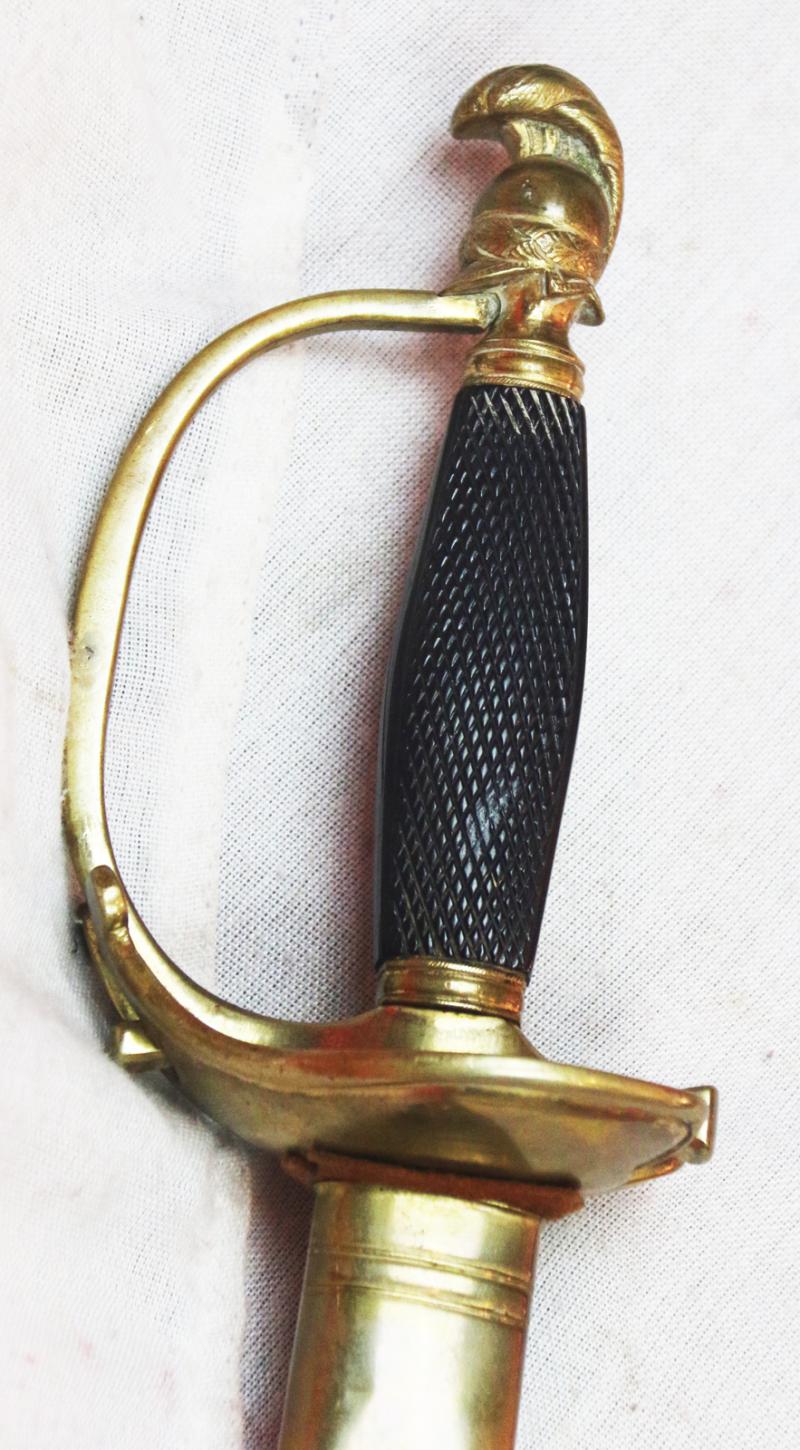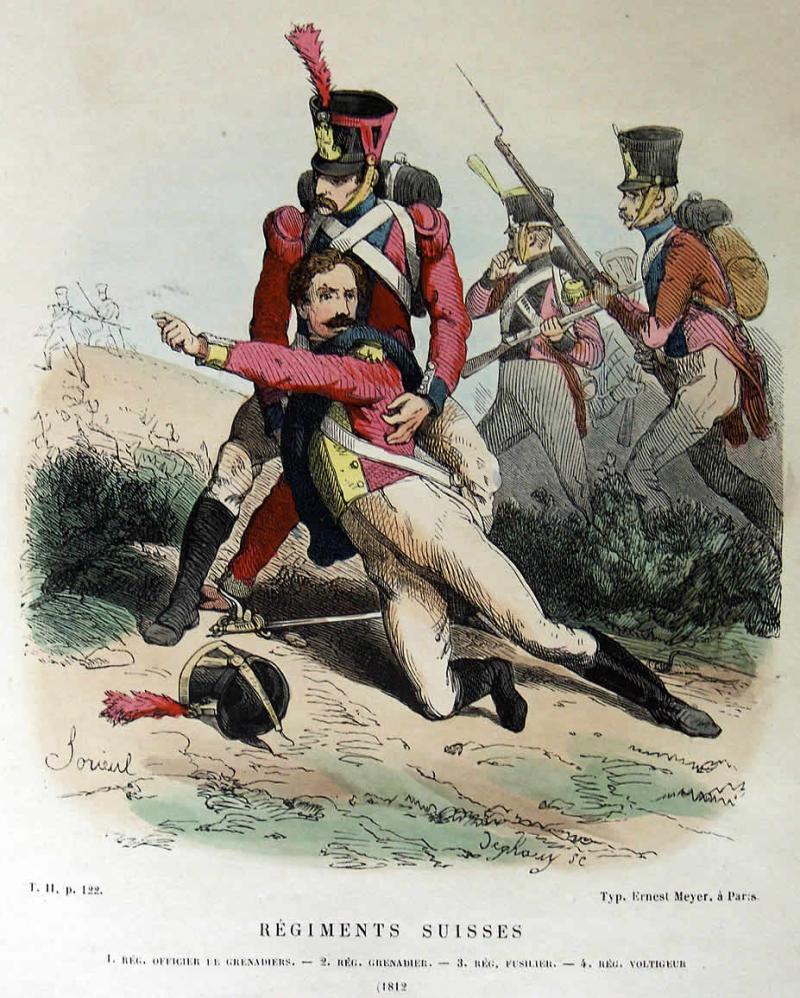A Beautiful Napoleonic Wars Swiss Mercenary Line Infantry, The 1ère Régiment Suisse, Officer's Blue and Gilt Epee. Some Officers & Men Of the Swiss Regt. Were Sent to The French Mediterranean Squadron's Ships at the Battle of Trafalgar
Maker marked by Jakob Girtanner, Degenschmied in St. Gallen, recorded from 1789.
Boat shaped original copper gilt hilt with French form Roman helmet pommel, single knucklebow, chequered carved ebony grip. Superb, duluxe 'Blue & Gilt' and engraved blade, with makers name engraved at the ricasso. In its original scabbard, that bears a good field service contemporary leather repair
From our recently acquired museum grade very rare collection of French Napoleonic swords.
The 1st Swiss Regiment (French: 1ère Régiment Suisse) was a Swiss mercenary line infantry regiment in the French Imperial Army during the Napoleonic Wars. During the expansion of the Imperial Army in 1803, Napoleon decreed the formation of four Swiss mercenary regiments, one of these later becoming the famed 1st Swiss. After a short time serving in Southern Italy, notably serving at the Battle of Maide, the 1st Swiss were sent to Poland for the impending Invasion of Russia. During the invasion, the regiment remained in the reserve, but served with honour, notably at the Battles of Polotsk and later the crossing of the Berezina. After retreating from Russia, elements of the regiment served during the minor campaigns until May 1814. The regiment was then reformed under the Bourbon restored monarchy, and continued into the Royal Guard until its final disbandment in 1830.
Interestingly, and historically, in 1805, according to regimental records, parts of the regiment was embarked on the Mediterranean Squadron's ships at the Battle of Trafalgar, where one officer was wounded.
By mid-1805, the regiment was consolidated within the new Kingdom of Italy with the Staff and 1st Battalion based at Bastia, the 2nd Battalion on Elba, the 3rd Battalion near Modena, and 4th Battalion in Genoa.
Napoleonic Wars campaigns and battles of the Swiss Regiments;
Battle of Trafalgar { regimental contingent}
Invasion of Naples
Battle of Castelfranco Veneto
Battle of Maida
Russian Campaign
First Battle of Polotsk
Second Battle of Polotsk
Battle of Berezina
War of the Sixth Coalition
Siege of Bremen
Siege of Maastricht
Battle of Wavre
On 27 November 1803, authorised articles were signed in which a new Swiss infantry regiment was to be created. However, it was not until March 1805, just before the Ulm Campaign, that the new French emperor, Napoleon, ordered the reorganisation of the Swiss troops by imperial decree. The remaining three Swiss Demi-brigades, which were the result of the merger of the original six Swiss demi-brigades of the Helvetic Legion. The men of these remaining small units were merged to form the new 1st Swiss Regiment, formed by imperial decree on 15 March 1805. The 1st Swiss Demi-Brigade was based in La Rochelle, where it was dissolved on 11 May 1805 to provide the 3rd Battalion of the new regiment. The 2nd Swiss Demi-Brigade formed the 4th Battalion a month later when it was based in Livorno. The 3rd Swiss Demi-Brigade was split, sourcing the personnel for the 1st and 2nd Battalions on 5 July 1805 while in Bastia, Corsica.
Following the disaster of the battle at Maida, the populace of Calabria (a fiercely pro-Bourbon province of the newly created Kingdom of Naples) rebelled against King Joseph Bonaparte. On 5 July 1806, the regiment and the remainder of Reynier's army were still retreating when it came upon the village of Marcellinara, desperate for food and water. To the amazement of the French, they were welcomed enthusiastically by the populace shouting "Long live the British" and "Death to the French", once again because they were mistaken for British soldiers. However, this comical situation ended tragically, when the Swiss opened fire on the populace, and the village was sacked.
As Napoleon's new Grande Armée assembled in the eastern parts of the Duchy of Warsaw, the need for Swiss troops became apparent. Napoleon even said, "We must pay serious attention to the Swiss regiments". He went on to call for a major effort to recruit the regiments up to strength and bring about their organisation. As a result, over the next year's course, the regiments were gradually reassembled, and each received a new regimental artillery company. Each artillery company composed of two 3-pounder mountain field cannon.
On most levels, Napoleon's campaign against Russia was a hugely complex series of events. For the Swiss regiments, it was much simpler – it consisted of three major engagements separated by long stretches of inactivity. The First Battle of Polotsk and Second Battle of Polotsk are amongst the least known actions of the campaign because they took place far from the watchful eye of Napoleon. However, the Battle of Berezina is better known, but the role played by the Swiss in that engagement is not always clearly described. Still, in all three instances, the Swiss covered themselves with glory and provided some of the most heroic episodes in the story of Napoleon's foreign troops.
On 17 August, at the First Battle of Polotsk, General Wittgenstein attacked the French in force, inflicting a sharp reserve on the II and VI Corps where Oudinot was wounded, and command was given to Marshal St Cyr, commanding VI Corps. The latter earned his Marshal's baton on the 18th when he counter-attacked and drove off the Russian Corps. During the engagement, the 1st, 2nd, and 3rd Swiss Regiments were initially not engaged, but the 18th St Cyr placed them in reserve as a precaution in case the action went against the French.
St Cyr is said to have noted:
"I know the Swiss. I had a battalion of the 1st Swiss Regiment under my orders at Castlefranco in Italy. The French are more impetuous in an advance, but if it comes to a retreat, we can count on the calm and courage of the Swiss"
— General de Division Laurent de Gouvion, Marquis de Gouvion-Saint-Cyr
The second fight for Polotsk was one of the campaign's most savage battles, conducted at night in a town full of blazing wooden buildings. Once the outer perimeters were breached, the fighting became hand-to-hand in the streets and houses, but the Swiss maintained their discipline and organisation throughout.
General Merle told Napoleon that he thought that every Swiss soldier deserved to be decorated for the Battle of Berezina, and he persuaded the Emperor to award the Swiss sixty-two crosses of the Legion of Honour. Unfortunately, the order to that effect was lost, and so the deserving officer and men of the Swiss regiments never received any officer recompense for their valour. However, their performance was accorded proper recognition by their countrymen, who viewed them as heroes whose actions were a source of national pride.
In 1813 On 10 October, the 1st Swiss along with fifty recruits of the 4th Swiss Regiment joined the Bremen garrison. The town had 30,000 inhabitants, which were of dubious loyalty to the Emperor. The forces' arrival was quite timely for the French commandant, Colonel Thuillier, as on 13 October, the town was assaulted by a mixed force of 4–5,000 Russian Cossacks and Prussian Freikorps under General Tettenborn. The voltigeur company under Captain Segesser was assigned to dispute the possession of the town's eastern suburb, and a French official who observed the combat noted that the Swiss "shot with such marvellous accuracy that any enemy soldier who showed himself was soon dead or wounded".
After Napoleon returned from Elba, during the 100 Days war, those that remained loyal to Napoleon, were formed into a regiment under the command of Colonel Christopher Stoeffel, who had been a captain in the 3rd Swiss in 1807 but had served exclusively in staff posts thereafter. A single battalion was formed in that regiment and served in General Vandamme's III Corps during the Waterloo Campaign, notably at the Battle of Wavre where it was wiped out. This regiment used the uniform and eagles of the 1st Swiss.
This is a very rare Napoleonic sword of Napoleon's early Consul to Empire period. Its scabbard had has long service repairs .
Code: 25400
2850.00 GBP









